Short tulles in the kitchen: features, types and selection criteria
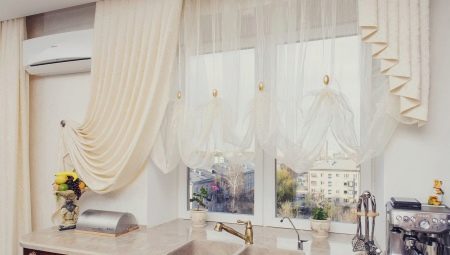
Kitchen tulle is a relatively inexpensive way to make a home-style room warm and cozy. But the traditional floor-length model may turn out to be too brand-name, it will quickly acquire an unsightly appearance; the use of a short analogue will help to avoid this. What can be a short tulle, how to fix the curtain and what to look for when choosing - this is the article about this.
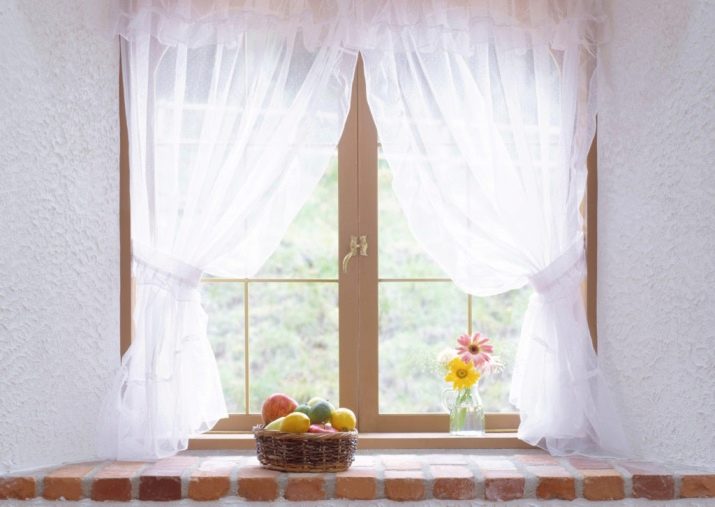


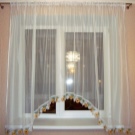
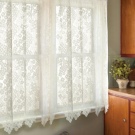
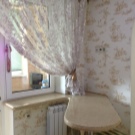
Advantages and disadvantages
A short tulle in the kitchen protects the room from the scorching sun rays, but does not impede the penetration of sunlight into the room. At the same time, tulle, unlike blinds or rolled analogs, makes the interior softer and more comfortable. Light airy tulle will make the kitchen visually more spacious and light.
At the same time, we must not forget that the kitchen is a place where textiles fail quickly enough. It is a short tulle that is a choice in favor of practicality without compromising an attractive appearance when decorating a window.
Short tulle is the best option for families with small children and pets. They are also suitable for those kitchens where tables are located by the window or a window sill is used as a countertop.
Such a curtain is cheaper than an analogue on the floor, it is easier to remove and wash it. And the window sill remains free, you can place potted plants on it without the fear that the tulle will get dirty.
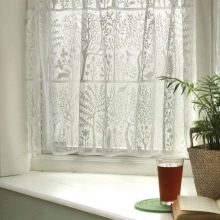
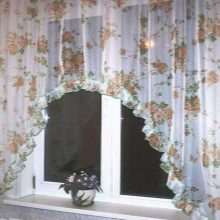
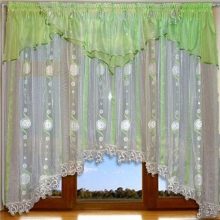
The disadvantage of short models is that it is not always possible to achieve with their help those interior solutions that are possible when using analogs in the floor. Not for every interior you can pick up a short tulle, as a rule, these are pompous classic interiors, baroque kitchens.Still, such interiors require longer and more luxurious models. Short tulle is not entirely appropriate in large kitchens.
If there is a balcony door, then short models may also not look their best. In a draft, a short tulle can take off, rising up, which is inconvenient and not very beautiful.
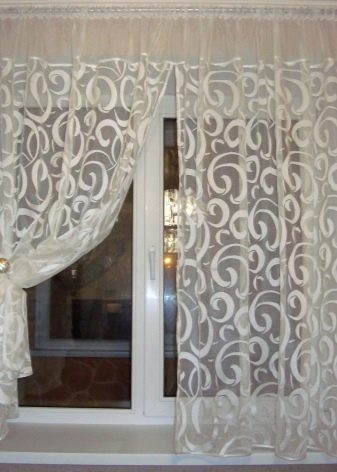
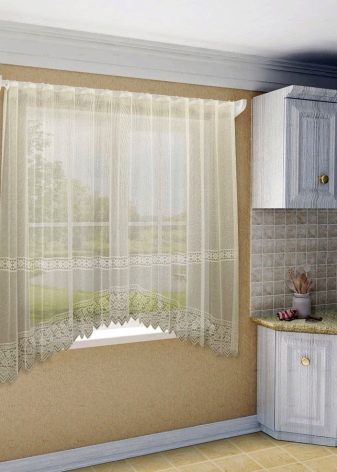
Views
Differences may relate to the material of manufacture. Let's consider the most common options.
- Organza. Silk or polyester blend fabric. It is a translucent, lightweight, but quite dense fabric. Suitable for the formation of lush folds, draperies. Easy to clean, does not wrinkle when washing, and transmits light well.
An important point: such a fabric does not allow air to pass through well. It can be used for a dining room, but for a kitchen where they often cook, organza tulle is not the best option.
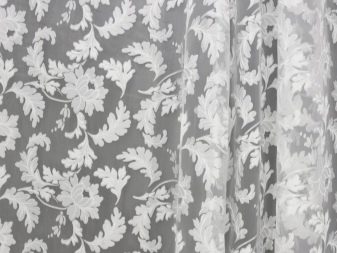

- Veil. Translucent fabric with a smooth surface, soft and pleasant to the touch. It is softer than organza, making it possible to form more frequent folds and softer draperies. The basis can be silk, cotton and artificial fibers, the greatest strength and wear resistance will have a veil based on polyester. Due to the peculiarities of weaving, the fabric transmits and diffuses light.
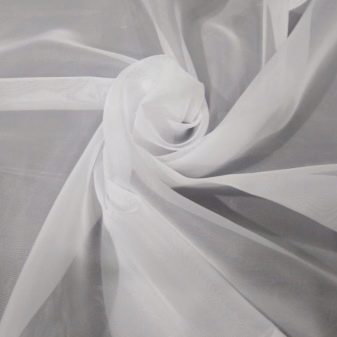
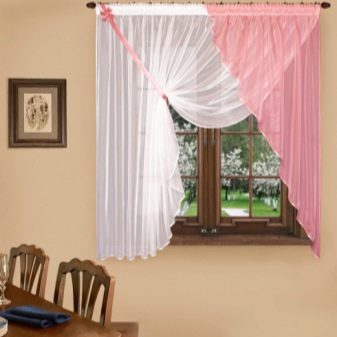
- Kiseya. A translucent fabric that is made up of thin vertical stripes or threads.
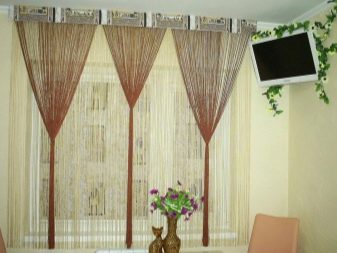
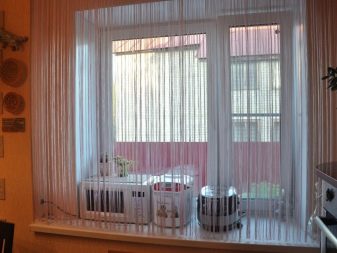
- Chiffon. Semi-transparent fabric based on silk or cotton threads.
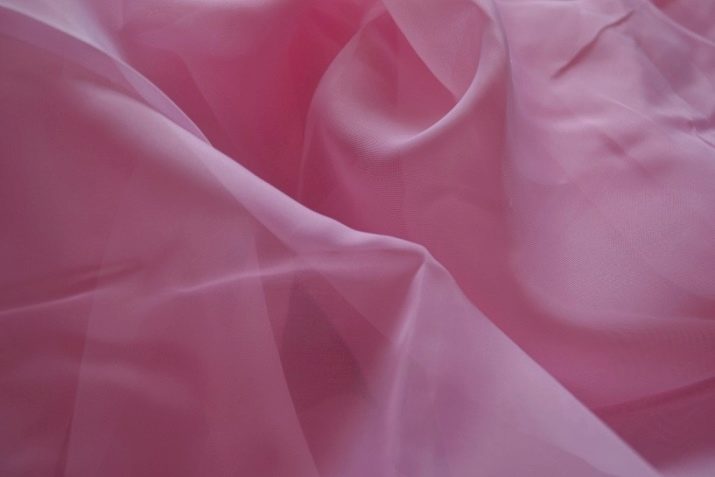
- Net. It looks like a fine elastic mesh, usually combined with a fabric or lace curtain. It is not recommended to use a net without a thicker padding, as it will not protect from the sun.
In addition, it is not recommended to use the mesh model in a house where allergy sufferers live. The thing is that the material attracts dust.
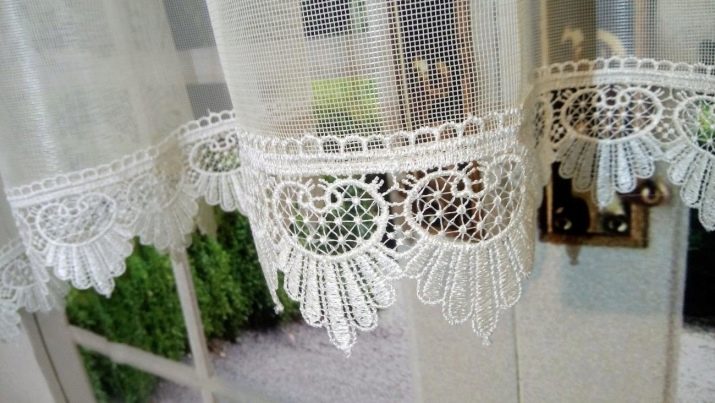
- Cobweb. From the name it is clear that the fabric is a matter based on randomly located fibers. The result is light, almost weightless matter. Despite the seeming airiness, the cobweb is very durable.

- Thread. Such curtains are vertically oriented fabric strips or threads. Beads, crystals, fringes and other decor can be strung on the thread.

Depending on the features of the fastening and the presence of decor, it is possible to distinguish tulles that cover the entire window, are symmetrically located on both sides of the window or are thrown to one of the sides. The latter option is preferable if there is a gas stove next to the window. It is also convenient if you need to frequently ventilate the kitchen.
Quick access to the window can also be obtained using two-half tulle. They can be left hanging loose, or the ends can be pulled together to form beautiful draperies.
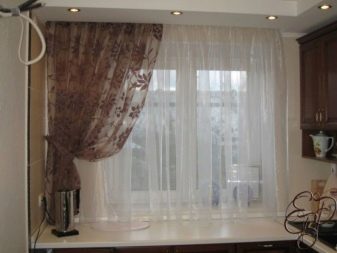

The photo curtain looks bright and unusual when a picture is applied on a transparent curtain by means of photo printing. It can be unrelated elements or 2 halves of tulle form a single composition (image - landscape, still life). In any case, photo printing on curtains makes it easy enough to transform the kitchen and make it unique. Thanks to modern technologies, the drawing can withstand multiple washes, the composition of the paint is safe for humans, does not fade, does not fade in the sun.
Since the photo printing is applied to smooth thin curtains, the finished product perfectly transmits air and light, and the pattern prevents the sun from heating the kitchen.

Design
By design, curtains can be conditionally divided into classic and modern. The classics are characterized by the use of snow-white tulle or an analogue of a pastel shade. The presence of a small, dull pattern is acceptable. Such tulle usually has picturesque folds, can be supplemented with lambrequins or other decorative elements.

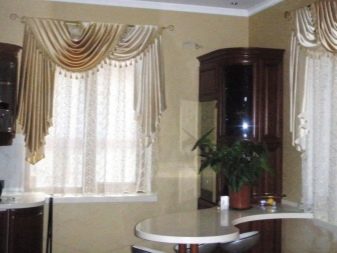
Modern versions of tulle can be not only white, but also bright. For Provence, lace models are suitable; for interiors in the style of minimalism, it is better to choose translucent options with a smooth surface.
Fringed models will emphasize the romance and originality of the interiorAlso, this decor is appropriate in baroque interiors.
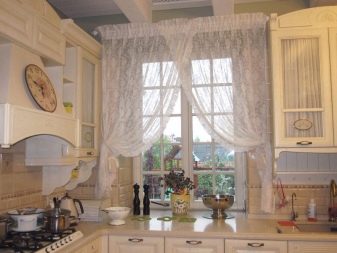
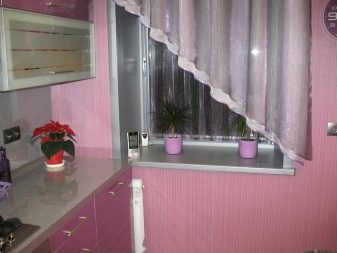
The tulle arch looks like an arch, that is, it is longer at the ends and shorter in the central part. This window design is suitable for both spacious and small kitchens. Such tulles bring lightness and airiness into the room.

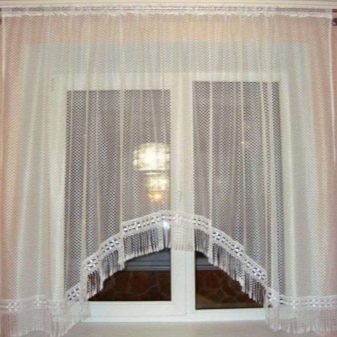
For classic and small kitchens, it is better to purchase tulle in white or cream shades, it will visually expand the space. If the choice fell on the creamy version, remember that it can be warm and cold. Cool tones are suitable for south-facing kitchens. For rooms facing north, it is better to choose models in warm colors.
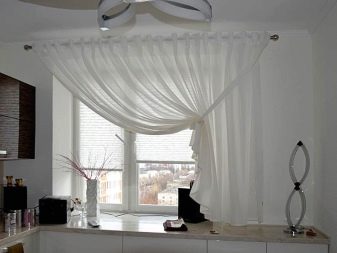
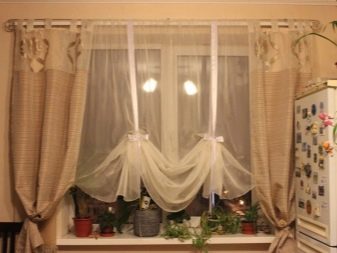
Orange tulle is also considered successful for the kitchen. A warm shade will make the kitchen more comfortable and help to visually expand the room. In addition, orange helps to improve appetite.
Green tulle is another option suitable for the kitchen. Calm green has a beneficial effect on the human nervous system, brings notes of naturalness, natural greenery to the room.
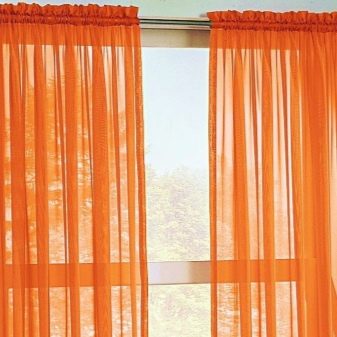

The light blue color of the curtains will make the room cooler, lighter and more airy. However, blues and blues are conducive to contemplation, but can cause impaired appetite. The lilac color will also bring a feeling of coolness and mystery to the room, but it is also advisable to dilute it with other colors.
The gray tone can be considered universal. The tulle of this color appears sometimes darker, sometimes lighter, depending on the degree of lighting. This shade will fit into both high-tech interior and Provence style.

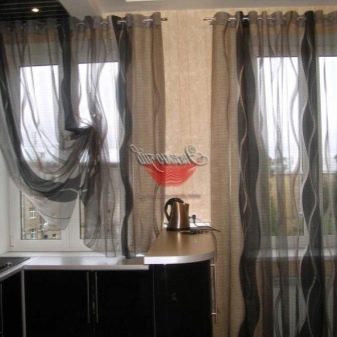
Transparent tulle of brown or coffee shade looks noble, brings comfort and a sense of security to the room. However, it is better not to combine such tulle with dark brown furniture, otherwise the interior will turn out to be overly gloomy.
Red is the color of energy, life, but in the kitchen this shade can look too bright and aggressive. This will be avoided, firstly, by choosing the right shade (more muted, noble), and secondly, the dosage of this color and combination with other shades.
Pink is especially good for Provence kitchens. It brings lightness, comfort to the room and is best combined with wooden furniture with a matte surface.

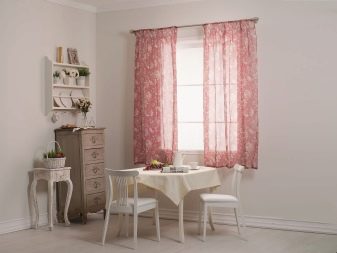
Selection recommendations
If the task is to visually expand the room, choose tulle in light warm shades. Products with stripes will also help to solve this problem. Vertical ones will make the ceiling visually higher, horizontal ones will increase the area of the kitchen. In a small kitchen, products with voluminous embroidery and large patterns look ridiculous.
The material should be practical, easy to wash, not form creases and folds after washing. The best option is models made of synthetic and mixed materials.
A ready-made curtain is convenient, but it is not always possible to find an option that is ideal in length. If you have to trim yourself, stop at a length just above or below the sill line. Tulle should not lie on the windowsill. Not the best length - to the middle of the window, it is better to cut it above or below this line.
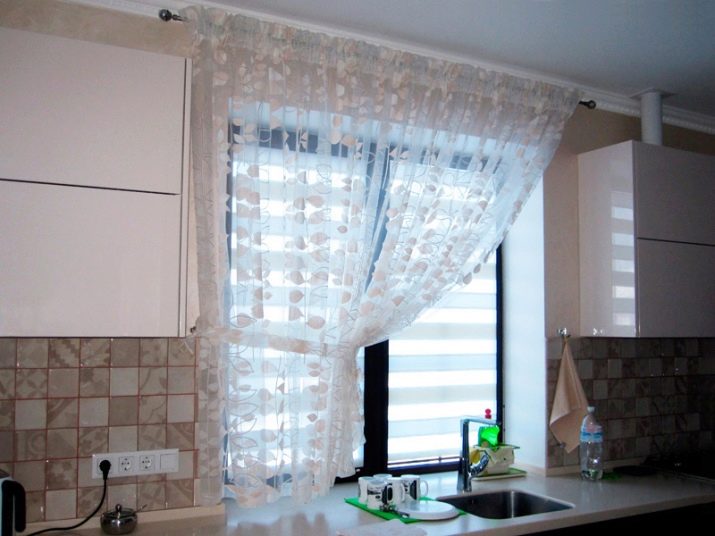
Mounting methods
There are several ways to attach the tulle. Eyelets will help to form beautiful identical folds, as well as to perfectly hold the top of the tulle without deforming it.
Tulle holds on to the rings no worse, but at the same time we must not forget that rings are also an element of kitchen decor. This means that they must match the overall style of the room.
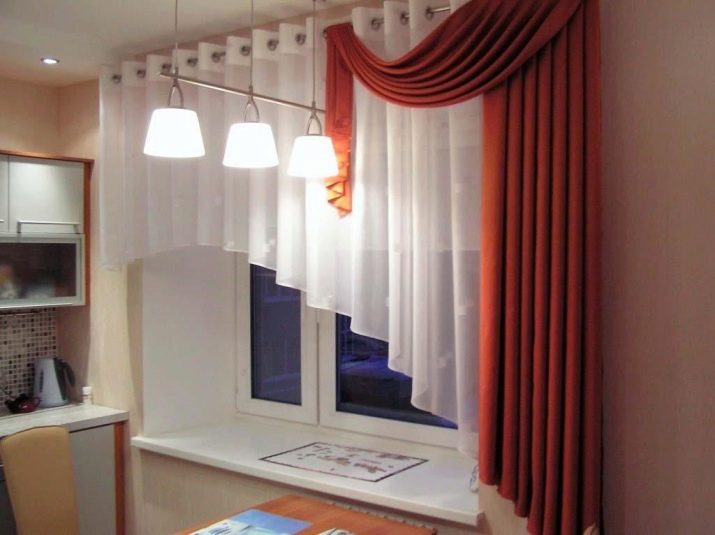
If the options for fastening to rings seem too rough (and this sometimes happens when a combination of delicate tulle and metal rings), you should consider the option of fastening textiles to loops. They can be made from the same material as the tulle, or a denser fabric of the same shade.
For romantic interiors, you can experiment with this method of fixing tulle, such as strings. However, this mounting method is not suitable for every interior. In a classic style, a loft and a number of others, they will be inappropriate.
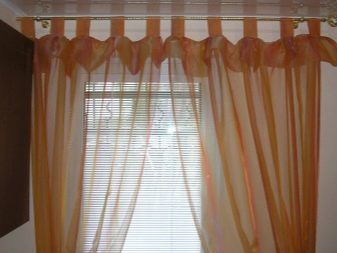
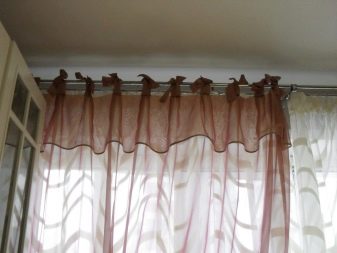
Beautiful examples
- Red tulle became an accent of the interior, attracted attention to the window opening. White tulle helps to avoid aggressiveness and balance red. The slanting tulle also helps to create accents and makes the room more comfortable.
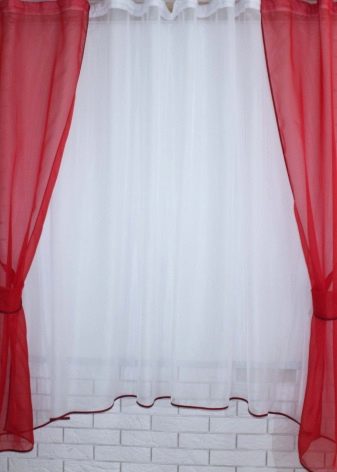
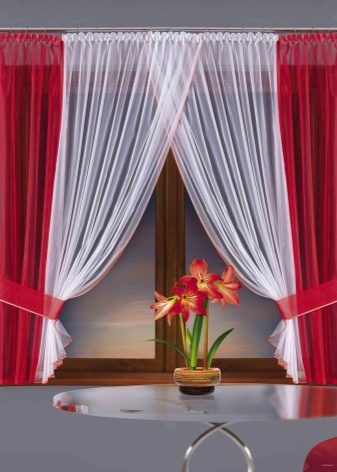
- Airy snow-white tulle makes the interior in vintage style even more relaxed and light. However, without turquoise lambrequins, window openings would look too simple and unfinished. In addition, this combination "supports" the white and turquoise color scheme of the interior.
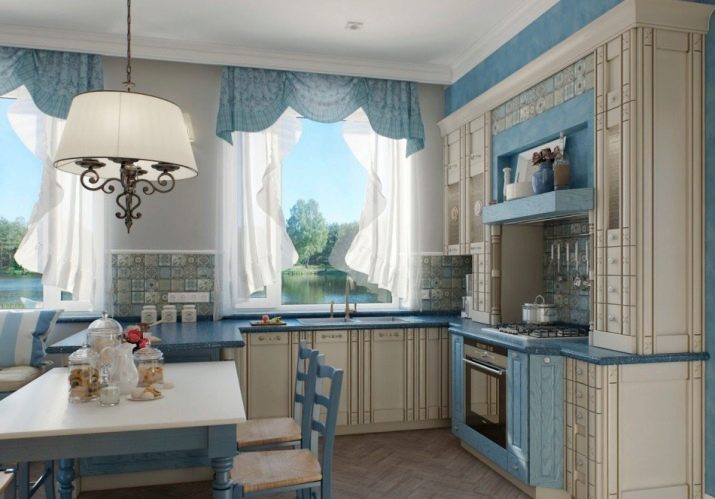
- The Provence style interior has acquired a finished look thanks to the lush snow-white tulle, distributed symmetrically on both sides of the window. Such a model will not protect the room from the bright sun, but for these purposes there are Roman blinds on the window.
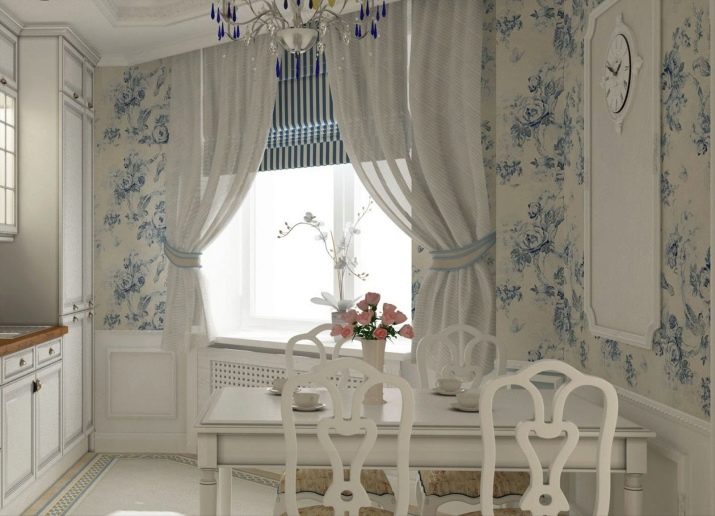
- Floral print on the photo curtains is more than appropriate. Do not be afraid of large drawings, the main thing is that the shade of the canvas is combined with one or another element of the kitchen. You can achieve perfect evenness of the tulle, but small soft folds will not disturb the perception of the pattern. Moreover, due to them, the image will appear more voluminous.
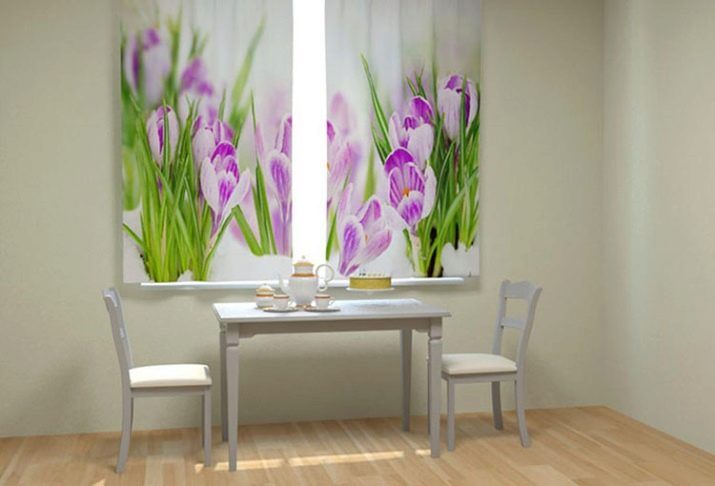
For information on how to choose curtains for the kitchen, see the next video.








